External links
![]() This article incorporates text available under the CC BY-SA 3.0 license.
This article incorporates text available under the CC BY-SA 3.0 license.
![]() This article incorporates text available under the CC BY-SA 3.0 license.
This article incorporates text available under the CC BY-SA 3.0 license.
David M. Bunis | |
|---|---|
| Born | June 3, 1952 |
| Occupation | Linguist |
| Spouse | Mattat Adar-Bunis |
| Children | Ivri (born 1999), Or, Hallel, Paz |
David Monson Bunis (Hebrew: דוד מונזון בוניס, born June 3, 1952, to Jacob and Marsha Monsohn Bunis) is a professor in the Department of Hebrew and Jewish Languages, Mandel Institute of Jewish Studies, at the Hebrew University of Jerusalem and heads its program in Judezmo (or Ladino) studies. He is also an advisor to the Israel Autoridad Nasionala del Ladino and a member of the Akademia Nasionala del Ladino. He is the editor of Languages and Literatures of Sephardic and Oriental Jews (Jerusalem, 2009), co-editor of Massorot, a Hebrew-language journal devoted to the study of Jewish language traditions, and author of books and articles on the Judezmo language and its literature.
After his doctoral dissertation on the Hebrew-Aramaic component of Modern Judezmo (also known as Judeo-Spanish, Ladino, Spanyol) was accepted in 1980 by the Department of Linguistics, Columbia University, David M. Bunis joined the Faculty of Humanities of the Hebrew University of Jerusalem as its Judezmo Studies specialist. In 2006 Bunis was appointed full professor in the Hebrew University's Department of Hebrew and Jewish Languages. In addition to his teaching responsibilities, Bunis supervised research projects on Judezmo language and literature supported by academic funding agencies in Israel and abroad. He participated in numerous international conferences on Judezmo and Jewish language research. Bunis has served as an advisor to the Israel Autoridad Nasionala del Ladino (National Authority for Ladino Language and Its Culture), the Israel Ministry of Education (Ladino programs), academic institutes in Israel, the United States, and Europe, and research funding agencies in Israel and abroad. He acted as academic chairman of the Misgav Yerushalayim research center (2006-2009), chairman of the Samuel Toledano Prize committee (2004), and a member of the Israel Prize in Jewish languages selection committee (2013). He is co-editor of Massorot and a member of the editorial boards of several journals devoted to linguistics and Jewish languages. In 2006 David Bunis was awarded the Yad Ben Zvi Life’s Work Prize for his pioneering contributions to Judezmo Studies. In 2013 he received the EMET Prize for the Study of Jewish Languages. In 2015 he became an Académico Correspondiente Extranjero of the Real Academia Española and in 2018 a member of the Akademia del Ladino en Israel. Bunis is a descendant of the Monsohn Family of Jerusalem and a grandson of Jerusalem-born Rabbi Menachem Mendel Monsohn.
![]() This article incorporates text available under the CC BY-SA 3.0 license.
This article incorporates text available under the CC BY-SA 3.0 license.
![]() This article incorporates text available under the CC BY-SA 3.0 license.
This article incorporates text available under the CC BY-SA 3.0 license.

Yiddish is a West Germanic language historically spoken by Ashkenazi Jews. It originates from 9th century Central Europe, providing the nascent Ashkenazi community with a vernacular based on High German fused with many elements taken from Hebrew and to some extent Aramaic. Most varieties of Yiddish include elements of Slavic languages and the vocabulary contains traces of Romance languages. Yiddish is primarily written in the Hebrew alphabet.
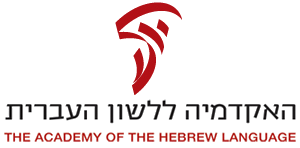
The Academy of the Hebrew Language was established by the Israeli government in 1953 as the "supreme institution for scholarship on the Hebrew language in the Hebrew University of Jerusalem of Givat Ram campus."

Jewish languages are the various languages and dialects that developed in Jewish communities in the diaspora. The original Jewish language is Hebrew, supplanted as the primary vernacular by Aramaic following the Babylonian exile. Jewish languages feature a syncretism of Hebrew and Judeo-Aramaic with the languages of the local non-Jewish population.
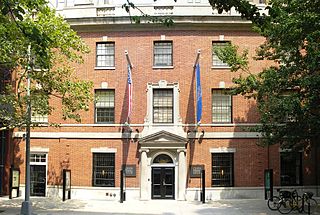
YIVO is an organization that preserves, studies, and teaches the cultural history of Jewish life throughout Eastern Europe, Germany, and Russia as well as orthography, lexicography, and other studies related to Yiddish. Established in 1925 in Wilno in the Second Polish Republic as the Yidisher Visnshaftlekher Institut (Yiddish: ייִדישער װיסנשאַפֿטלעכער אינסטיטוט, pronounced [ˈjidiʃɛr ˈvisn.ʃaftlɛχɛr instiˈtut], Yiddish Scientific Institute, its English name became Institute for Jewish Research after its relocation to New York City, but it is still known mainly by its Yiddish acronym. YIVO is now a partner of the Center for Jewish History. Formerly, they had linguists whose main occupation was deciding on grammar rules and new words, and during this time they were seen in the secular world to serve as the recognized language regulator of the Yiddish language. However, YIVO no longer serves this purpose. Nevertheless, the YIVO system is still commonly taught in universities and known as klal shprakh and sometimes "YIVO Yiddish".
Menachem Elon was an Israeli jurist and Professor of Law specializing in Mishpat Ivri, an Orthodox rabbi, and a prolific author on traditional Jewish law (Halakha). He was the head of the Jewish Law Institute of the Hebrew University of Jerusalem.
Ein Keloheinu is a well known Jewish hymn. Orthodox Jews pronounce it as Ein Kelokeinu when referring to it outside of prayer, in order to avoid taking the name of God in vain or otherwise violating the sanctity of reverence to the Almighty.

The revival of the Hebrew language took place in Europe and Palestine toward the end of the 19th century and into the 20th century, through which the language's usage changed from the sacred language of Judaism to a spoken and written language used for daily life in Israel. The process began as Jews from diverse regions started arriving and establishing themselves alongside the pre-existing Jewish community in the region of Palestine in the first half of the twentieth century, when veteran Jews in Palestine and the linguistically diverse newly arrived Jews all switched to use Hebrew as a lingua franca, the historical linguistic common denominator of all the Jewish groups. At the same time, a parallel development in Europe changed Hebrew from primarily a sacred liturgical language into a literary language, which played a key role in the development of nationalist educational programs. Modern Hebrew was one of three official languages of Mandatory Palestine, and after the Israeli Declaration of Independence in 1948, one of two official languages of Israel, along with Modern Arabic. In July 2018, a new law made Hebrew the sole official language of the state of Israel, giving Arabic a "special status".

Judaeo-Spanish or Judeo-Spanish, also known as Ladino, is a Romance language derived from Old Spanish. Originally spoken in Spain, and then after the Edict of Expulsion spreading through the Ottoman Empire as well as France, Italy, the Netherlands, Morocco, and England, it is today spoken mainly by Sephardic minorities in more than 30 countries, with most speakers residing in Israel. Although it has no official status in any country, it has been acknowledged as a minority language in Bosnia and Herzegovina, Israel and France. In 2017, it was formally recognised by the Royal Spanish Academy.
Aki Yerushalayim is an Israeli magazine in Judaeo-Spanish (Ladino) published in print two to three times a year between 1979 and 2016, and exclusively online since 2019.
Autoridad Nasionala del Ladino is a national Israeli organisation created in 1997 with the goal of preserving and safeguarding Judaeo-Spanish, commonly known as Ladino.
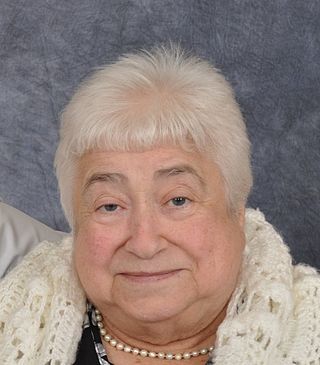
Matilda Koen-Sarano, is an Israeli writer. Born to Turkish Jewish parents, she is one of the most widely known writers in the Ladino language.

Joseph Yahalom is a professor of Hebrew literature at the Hebrew University of Jerusalem. Since 1983, he has been a member of the Academy of the Hebrew Language.
Paul Wexler is an American-born Israeli linguist, and Professor Emeritus of linguistics at Tel Aviv University. His research fields include historical linguistics, bilingualism, Slavic linguistics, creole linguistics, Romani and Jewish languages.
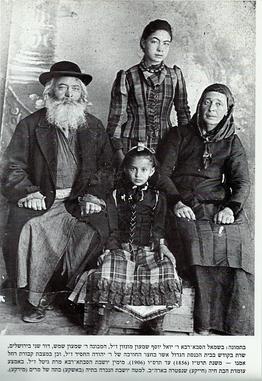
Abraham-Leib ben Yitshak Monsohn, known as “Avrom-Leib Shames” (1804-1870), was a member of the first Ashkenazi prayer quorum of Perushim in the Old Yishuv community of Jerusalem at the beginning of the nineteenth century. He was born in Mogilev, and according to family legend, made his way to Jerusalem on horseback in 1832 with other students of the Vilna Gaon. His first wife was Zelda; he later married Dahde, believed to have been of the Maghrebim or North African Jewish community of Hebron. Abraham-Leib was the first beadle and caretaker (shamash) of the Menachem Zion and Rabbi Yehudah He-Hasid (Hurva) synagogues in the Old City of Jerusalem, and of Rachel's Tomb on the outskirts of Bethlehem. He was also an aid to community leader Shlomo Zalman Zoref and in 1836 accompanied him to Egypt to obtain the permission of Muhammad Ali to build the Hurva synagogue. Abraham-Leib's son, Yoel Yosef Shimon Monsohn, called “Shimen Shames,” later assumed the communal tasks his father had performed, by commission of Sir Moses Montefiore. He was in contact with communal leaders of the time such as Yosef Yoel Rivlin, and in fact with all the Russian Jews of the Old Yishuv, since he distributed the Jewish mail for the Russian post office in Jerusalem. Shimen Shames was married to Gittel, whose family migrated to Hebron with fellow members of the Chabad hasidic movement in Shklov in the 1820s. Members of the Monsohn family also intermarried with other Old Yishuv families such as descendants of the Schwartz, Honig and Getz Hacohen families.
Eastern Sephardim are a distinctive sub-group of Sephardic Jews mostly descended from Jewish families which were exiled from Iberia in the 15th century, following the Alhambra Decree of 1492 in Spain and a similar decree in Portugal five years later. This branch of descendants of Iberian Jews settled across the Eastern Mediterranean.
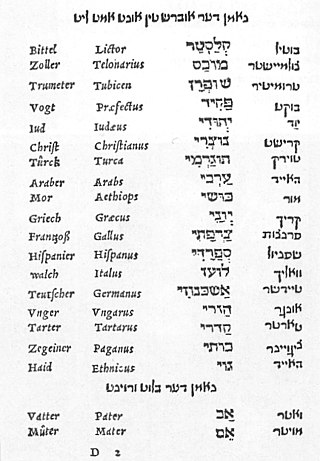
Vaybertaytsh or mashket, is a semi-cursive script typeface for the Yiddish alphabet. From the 16th until the early 19th century, the mashket font distinguished Yiddish publications, whereas Hebrew square script were used for classical texts in Hebrew and Aramaic, and "Rashi" script for rabbinic commentaries and works in Ladino.
Aron Rodrigue is the Daniel E. Koshland Professor in Jewish Culture and History at Stanford University.
Moshe Shaul, also known as Mosheh Sha'ul, was a Turkish-born Israeli journalist, writer and researcher of the culture of Sephardi Jews who worked on preserving the Ladino language.
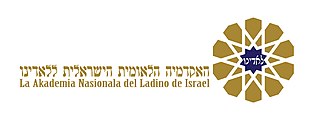
The Akademia Nasionala del Ladino (ANL) (English: National Academy of Judeo-Spanish) is a governing body on the study and use of the Ladino language, also known as Judeo-Spanish, in Israel, working within the framework of the Autoridad Nacional del Ladino.